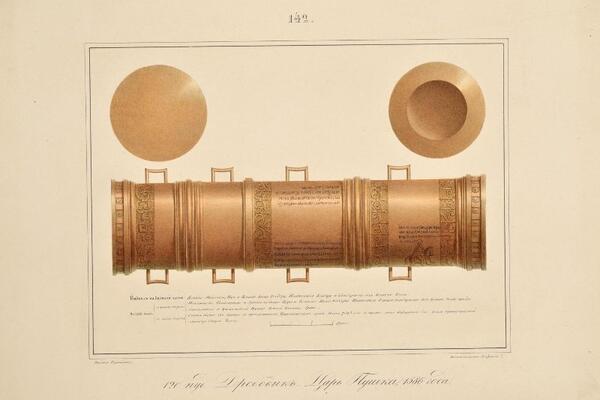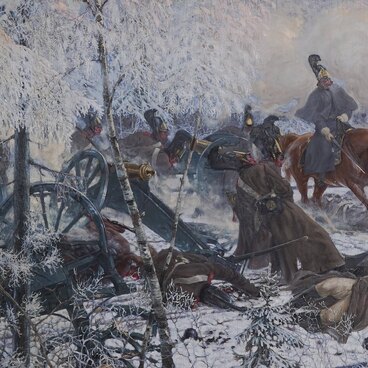In the 14th century, simple projectile weapons were replaced by gunpowder-firing artillery. Often the explosion occurred right at the moment when the fuse was lit, and gunners themselves suffered from it. In the 15th century, people learned to make gunpowder of varying grain sizes and the caliber of guns gradually increased. In the 16th–17th centuries, the technology of cannon casting was already well developed.
From 1568 to 1629, Andrey Chokhov, a cannon and bell caster in the Moscow Cannon Court, worked in Moscow. He made a lot of heavy guns, the most famous is the bronze Tsar Cannon.
Chokhov cast it in 1586 by order of Tsar Fyodor Ioannovich, in fact it was commissioned on the initiative of Boris Fyodorovich Godunov.
According to one version, the powerful gun was made as a combat weapon and the only time they wanted to use it for its intended purpose was in 1591, when the troops of Crimean Khan Ğazı Giray (Ğazı II Giray) were approaching Moscow. However, it never needed to fire. According to another version, the original plan was for the cannon to be displayed on Red Square near the Lobnoye Mesto as a symbol of state power.
Until the 20th century, the Tsar Cannon was considered to be a weapon (“a Russian shotgun”) for shooting small stones — grapeshot. Later, researchers considered it a bombard, a large gun for shooting at the walls of enemy fortifications. It needed to be buried in the ground during firing for stability.
For a long time, it remained a mystery whether at least one shot was fired from the cannon. The particles of gunpowder found inside the barrel and the caster’s personal seal (it was customary to leave it inside the barrel only after a test shot) suggest that it was. However, no other evidence, for example, scratches from gunstones, was found. In the 1980s, during its restoration, it was established that the gun was not finished: the inner part of the barrel was unprotected after casting, there were undulations, irregularities and burnt ground in it (perhaps it was mistaken for gunpowder previously). In addition, there was no touch hole.
Often the “Tsar” in the name of the cannon is explained by the grandiose size of the gun. However, initially the reason was different: the barrel of the cannon is decorated with a relief image of a horseman in a crown and with a scepter. The inscription indicates that this rider is Tsar Fyodor Ioannovich.
To move the cannon, four brackets were made on each side of it. Instead of the carriage, a mount with a fixed inclination angle was designed.
This lithograph was created by Pyotr Ivanovich Razumikhin, a Revel lithographer and draughtsman. He created many lithographed portraits, and landscapes, including the sheets “Picturesque Karamzin, or Russian History in Paintings” based on drawings by Boris Chorikov.
From 1568 to 1629, Andrey Chokhov, a cannon and bell caster in the Moscow Cannon Court, worked in Moscow. He made a lot of heavy guns, the most famous is the bronze Tsar Cannon.
Chokhov cast it in 1586 by order of Tsar Fyodor Ioannovich, in fact it was commissioned on the initiative of Boris Fyodorovich Godunov.
According to one version, the powerful gun was made as a combat weapon and the only time they wanted to use it for its intended purpose was in 1591, when the troops of Crimean Khan Ğazı Giray (Ğazı II Giray) were approaching Moscow. However, it never needed to fire. According to another version, the original plan was for the cannon to be displayed on Red Square near the Lobnoye Mesto as a symbol of state power.
Until the 20th century, the Tsar Cannon was considered to be a weapon (“a Russian shotgun”) for shooting small stones — grapeshot. Later, researchers considered it a bombard, a large gun for shooting at the walls of enemy fortifications. It needed to be buried in the ground during firing for stability.
For a long time, it remained a mystery whether at least one shot was fired from the cannon. The particles of gunpowder found inside the barrel and the caster’s personal seal (it was customary to leave it inside the barrel only after a test shot) suggest that it was. However, no other evidence, for example, scratches from gunstones, was found. In the 1980s, during its restoration, it was established that the gun was not finished: the inner part of the barrel was unprotected after casting, there were undulations, irregularities and burnt ground in it (perhaps it was mistaken for gunpowder previously). In addition, there was no touch hole.
Often the “Tsar” in the name of the cannon is explained by the grandiose size of the gun. However, initially the reason was different: the barrel of the cannon is decorated with a relief image of a horseman in a crown and with a scepter. The inscription indicates that this rider is Tsar Fyodor Ioannovich.
To move the cannon, four brackets were made on each side of it. Instead of the carriage, a mount with a fixed inclination angle was designed.
This lithograph was created by Pyotr Ivanovich Razumikhin, a Revel lithographer and draughtsman. He created many lithographed portraits, and landscapes, including the sheets “Picturesque Karamzin, or Russian History in Paintings” based on drawings by Boris Chorikov.




